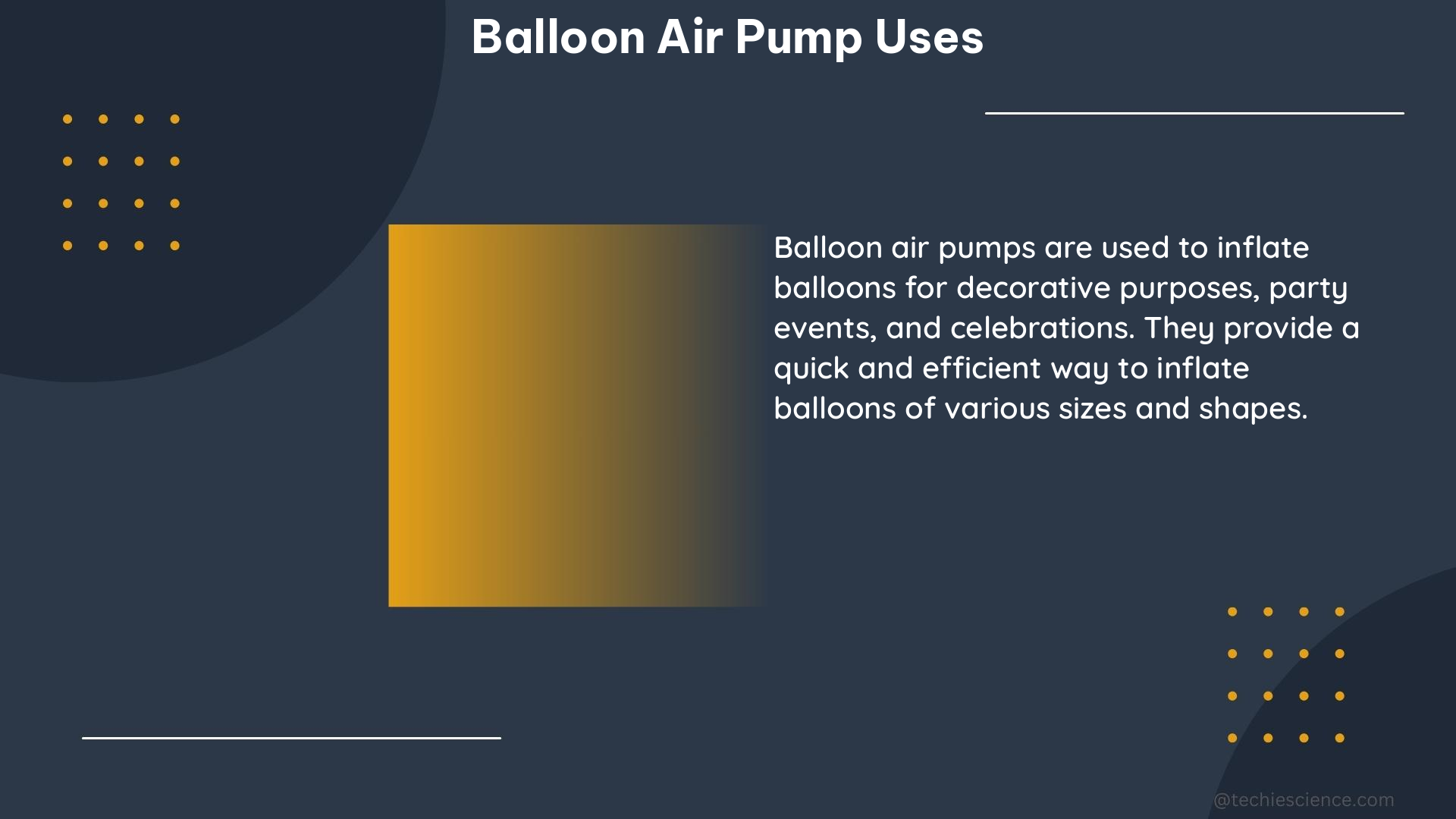Balloon air pumps are versatile tools that offer efficient and time-saving solutions for inflating balloons, whether for decorative purposes, event planning, or even medical applications. These pumps come in various types, each with its own unique features and capabilities, making them a valuable asset for a wide range of users.
Understanding the Types of Balloon Air Pumps
Single-Action Pumps
Single-action pumps are the most basic type of balloon air pumps. They work by pushing air into the balloon with each stroke, making them a simple and affordable option for inflating a small number of balloons. These pumps typically have a capacity of around 1-2 liters per stroke, making them suitable for inflating balloons up to 12 inches in diameter.
Double-Action Pumps
Double-action pumps, on the other hand, are more efficient than their single-action counterparts. They push air into the balloon on both the upstroke and the downstroke, effectively doubling the air output. This results in faster inflation times, making them ideal for inflating larger quantities of balloons. These pumps typically have a capacity of 2-4 liters per stroke, allowing them to inflate balloons up to 18 inches in diameter.
Electric Inflators
Electric balloon inflators are the most powerful and efficient type of balloon air pumps. These devices are powered by electricity, eliminating the need for manual pumping and providing a significant time-saving advantage. Electric inflators can inflate an 11-inch balloon in just 2 seconds, compared to over a minute with a manual pump. This makes them particularly useful for large-scale balloon decorations or events where time is of the essence.
Optimizing Inflation Parameters for Specific Applications

Balloon air pumps are not only used for decorative purposes but also have important applications in the medical field, particularly in the use of drug-coated balloons (DCBs) for vascular surgery.
A study conducted by researchers at the NCBI found that the inflation parameters of DCBs can significantly impact the delivery and retention of the drug (paclitaxel) in the target tissue. The study investigated the effects of transit time (the time the balloon spends in the artery) and balloon-to-artery ratio on the drug transfer and retention.
The key findings from the study are:
| Inflation Parameter | Drug Concentration in Tissue |
|---|---|
| 30-second transit time, 3-minute inflation time | ~450 ± 180 ng/mg |
| 3-minute transit time, 30-second inflation time | ~50 ± 25 ng/mg |
These results highlight the importance of optimizing the inflation parameters to ensure effective drug delivery and retention in DCB applications. By understanding the impact of these factors, medical professionals can make informed decisions to improve the efficacy of their treatments.
Factors to Consider When Choosing a Balloon Air Pump
When selecting a balloon air pump, there are several factors to consider:
-
Number of Balloons: If you need to inflate a large number of balloons, an electric inflator would be the most efficient choice, as it can quickly inflate multiple balloons simultaneously. For smaller quantities, a manual pump may be more suitable.
-
Balloon Size: The capacity of the pump, measured in liters per stroke, should be matched to the size of the balloons you need to inflate. Larger balloons require pumps with higher capacities.
-
Inflation Time: Electric inflators offer significantly faster inflation times compared to manual pumps, which can be crucial for time-sensitive events or decorations.
-
Portability: Manual pumps are generally more portable and lightweight, making them easier to transport, while electric inflators require a power source.
-
Budget: Manual pumps are typically more affordable than electric inflators, which may be an important consideration for some users.
By carefully evaluating these factors, you can select the balloon air pump that best suits your specific needs and requirements.
Conclusion
Balloon air pumps are versatile tools that offer a range of benefits, from time-saving inflation to optimized drug delivery in medical applications. By understanding the different types of pumps and their features, users can make informed decisions to select the most appropriate pump for their needs. Whether you’re planning a large-scale event or working in the medical field, balloon air pumps can be a valuable asset in your toolkit.
References:
- Balloon Filling Machine, Timed Quantitative Electric Balloon Pump, available at https://www.amazon.com/Balloon-Quantitative-Electric-Inflator-Birthday/dp/B0B51DPDN1
- Estefanny Villar-Matamoros, Lauren Stokes, Alyssa Lloret, Meagan Todd, Bryan W. Tillman, and Saami K. Yazdani, “Understanding the Mechanism of Drug Transfer and Retention of Drug-Coated Balloons,” NCBI, PMC9549471, published March 2023, available at https://www.ncbi.nlm.nih.gov/pmc/articles/PMC9549471/
- “Everything You Need To Know About Balloon Inflators Types,” Balloons Online, 2021-09-14, available at https://balloons.online/blog/everything-you-need-to-know-about-balloon-inflators-types/
- Electric Balloon Pump Timing Quantitative Professional Double Hole Inflator, available at https://www.amazon.com/Electric-Quantitative-Professional-Inflator-Function/dp/B0BN3WK5GD
- “Things You Should Know| Electric Balloon Pump Review – YouTube,” YouTube, 2022-02-04, video, 4:15, available at https://www.youtube.com/watch?v=znm9cOIaJEk

The lambdageeks.com Core SME Team is a group of experienced subject matter experts from diverse scientific and technical fields including Physics, Chemistry, Technology,Electronics & Electrical Engineering, Automotive, Mechanical Engineering. Our team collaborates to create high-quality, well-researched articles on a wide range of science and technology topics for the lambdageeks.com website.
All Our Senior SME are having more than 7 Years of experience in the respective fields . They are either Working Industry Professionals or assocaited With different Universities. Refer Our Authors Page to get to know About our Core SMEs.